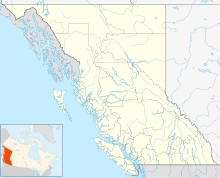Hedley Mascot Mine facts for kids
| Location | |
|---|---|
| Location | Hedley |
| Province | British Columbia |
| Country | Canada |
| Coordinates | 49°22′15″N 120°02′51″W / 49.370937°N 120.047562°W |
| Production | |
| Products | |
| History | |
| Opened | 1936 |
| Closed | 1949 |
The Mascot Mine of Hedley was a famous gold mine located on Nickel Plate Mountain. It was near the town of Hedley in the Similkameen region of southern British Columbia, Canada. This mine played an important role in the area's history.
Contents
Discovering the Mascot Mine
In 1899, a man named Duncan Woods was looking for new places to find gold. He noticed that most gold seekers avoided very steep areas. Duncan studied a map of Nickel Plate Mountain. He saw a small piece of land, about 40 acres, right on the edge of a huge cliff. This cliff dropped about 2,900 feet down to Twenty Mile Creek. Duncan decided to claim this difficult-to-reach spot for himself.
Keeping the Claim Alive
Duncan Woods named his claim the Mascot. Even though he had found gold, he could not get enough money to start digging. So, for many years, his only activity was paying a yearly fee. This fee allowed him to keep ownership of the land.
In 1904, another company, the Daly Reduction Company (DRC), wanted to build a tunnel through Duncan's land. They needed to reach another part of their own property. Duncan said no to their offer. Later, when DRC re-measured the land, the Mascot claim seemed smaller, only about 17 acres.
In 1909, the Hedley Gold Mining Co. (HGM) bought the DRC's operations. By 1920, HGM got permission from the government. They were allowed to dig a 200-foot tunnel through the Mascot claim without paying Duncan any money.
Building the Mine
After HGM closed down in 1931, Duncan Woods finally sold his Mascot claim. He sold it to a new company called Hedley Mascot Gold Mines (HMG). This company was owned by businessmen from British Columbia. Duncan received $150,000 for his claim. The deal also included company stock, a position as a director, and a free suite at a hotel in Penticton.
In 1933, Franklin D. Roosevelt was running for president in the United States. He promised to increase the price of gold. This made gold mining look very promising. Because of this, HMG was able to raise $3 million by selling shares to develop the Mascot Mine. HMG also bought 31 other nearby claims. However, there was not much flat land available to build all the necessary buildings. HMG workers used the old HGM tunnel from 1920 to drill test holes.
The company built a special building called a concentrator near the creek. This building used electricity from West Kootenay Power. They also installed an aerial tramway. This was like a cable car system that carried three-ton buckets of ore from the mine. The mine was about 0.5 kilometers higher than the concentrator. The cable stretched for about 1 mile. A road was also built up to the mine from further up the creek valley.
How the Mine Operated
The Mascot Mine started producing gold in 1936. Battery-powered trains pulled ore cars along an 18-inch narrow gauge track. The ore went from the mine to large storage hoppers. When the hoppers were full, the heavy tramway buckets would go down the mountain. Their weight helped power the cable system. The empty buckets going up carried supplies and employees changing shifts.
The gold concentrate was then loaded onto trucks. These trucks took it to the Vancouver, Victoria and Eastern Railway (VV&E) yards in Hedley. From there, the Great Northern Railway (GN) transported the product. It was sent all the way to a smelter in Tacoma, where the gold was separated.
In 1933, a company called Kelowna Exploration (KelEx) bought the neighboring HGM mine. KelEx was a part of the South American Development Company. The Mascot Mine and KelEx worked together. They connected their mine shafts, which helped with air flow and water drainage. In 1937, KelEx finished building a new access road. HMG then shared this road, replacing their old, worn-out route.
By 1941, the Mascot Mine could process 200 tons of ore every day. The company also processed ore from other nearby mines, like the Canty and Good Hope mines. Hedley Mascot Gold Mines stopped operating in 1949. KelEx closed its operations in 1955. However, mining in the area started again as a combined effort between 1988 and 1996.
What Remains Today
By the 1990s, the old Mascot Mine complex had been abandoned for a long time. Insurance companies were worried that visitors to the site might get hurt. They wanted to burn down the old buildings. But a group of people wanted to save the buildings and stopped these plans.
In 1995, the Upper Similkameen Indian Band helped by putting new roofs on several buildings. This helped to protect them from further damage. The province of British Columbia then bought the site for $740,000. Over the next few years, they worked to make the structures safe and stable. In 2003, the province provided $300,000 to prepare the site for tourists.
The site has many buildings packed closely together. These include old dormitories where workers slept, a cookhouse, and machine sheds. In 2004, the Mascot Mine site opened for tours. However, it closed again in 2017. In 2021, the province gave the Upper Similkameen Indian Band $800,000. This money helped with repairs and making the site stable. It also funded a new parking lot, an improved website, and better trails and stairs. The site reopened for visitors in 2023.


